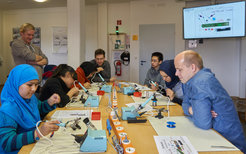Looking forward to Girls’ Day
Girls' Day 2022 is approaching: 26 girls between the ages of 10 and 18 are expected at the Fritz Haber Institute on 28 April from 9 am. They will be welcomed by FHI Director Prof. Dr. Beatriz Roldán Cuenya. Divided into small groups, the participants will go through six stations on this day and will be introduced to the world of natural sciences in an entertaining way. The six groups are named after famous female researchers such as Ada Lovelace, Marie Curie, Emmy Noether, Lise Meitner, Emmanuelle Charpentier and Mai-Thi Nguyen Kim. So the famous women scientists also have very familiar first names...

The stations in detail:
1. Laboratory/Technology - Torch Project
The electronics laboratory and the precision engineering department ask the participants to help them with an "assignment": For various experimental set-ups in the labs, the scientists need manually portable light sources with replaceable energy storage devices. The visitors should be part of it and complete the task.
2. Molecular physics - Project Cold
In the Molecular Physics department, the structure of molecules will be analyzed. This often happens at very cold temperatures. Find out why molecules are cooled and how cold they can get! At the end there is a lab visit.
3. Inorganic Chemistry - Dealing with Lab Waste
A research laboratory that handles a large number of chemicals inevitably produces many types of waste in addition to the desired products. These wastes can have hazardous properties and require expert handling to control the hazards. Visitors will be shown practical examples of the sometimes exciting challenges of handling laboratory waste.
4. Interface Science - Catalysis
In the past, the Institute developed ammonia synthesis and made it possible to make bread out of air. Today scientists study surfaces while chemical reactions take place on them. With new microscopes, we can even observe individual atoms, molecules or other small structures very precisely. This will help in the future to protect the planet with us humans and to make climate goals achievable. Because with the help of electrocatalysis it is already possible today to convert water and CO2 directly into hydrogen and hydrocarbons. Instead of making bread out of air as in the past, green fuels are now being made out of water and air! The participants will learn exactly how this works and how the important elementary processes are being elucidated.
5. Physical Chemistry - Lasers and Light
"Fluorescent objects": Fluorescence is the process by which a material absorbs light with high energy - for example UV light - and emits light with lower energy - often visible light. It is an important natural phenomenon used in research, but also in many industrial applications. We will discover some unexpected fluorescent objects in everyday life.
"Laser Maze": We will present different applications of lasers as used for experiments in the laboratory but also in industry. We give insights into the functioning of a pump-probe experiment and there is the possibility to shoot a laser beam independently by mirror adjustment at a target. Laser safety is provided.
"The fastest camera in the world": Photoreactions in molecules and solids occur on the time scale of femtoseconds (0.0000000000001 seconds). Electrical measurement methods are clearly too slow to observe such reactions in time. Participants will gain insight into how ultra-short laser pulses can be used to "film" the movement of electrons and atoms during the course of a photoreaction.
6. Theory - Virtual Laboratory
In the theory section, the researchers investigate how new molecules and materials can be designed on the computer. The visitors are shown how to do this and can try their hand at it themselves in the virtual lab.
